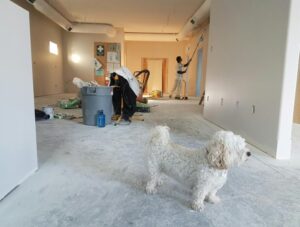Healthy breathing starts with clean, well-maintained indoor air. Today, more people understand that indoor air quality and health are closely linked, influencing everything from respiratory comfort to illness prevention. Whether at home, at work, or in shared community spaces, the air around us impacts immune function, energy levels, concentration, and the likelihood of respiratory infections spreading. Maintaining clean indoor air is not just a comfort upgrade; it’s a foundational part of protecting well-being.
Clean air is especially important during high-illness seasons, when viruses spread more easily through poorly ventilated indoor environments. Workplaces experience more absences, schools face classroom illnesses, and households end up juggling symptoms, recovery, and scheduling challenges.
During these times, many people rely on telehealth to get a doctor’s note online or obtain a medical certificate for leave when symptoms interfere with daily responsibilities. But improving indoor air can dramatically reduce how often these disruptions occur.
This guide explores the essential components of cleaner indoor air—ventilation, humidity management, HEPA filtration, and daily habits—and explains how optimizing these factors keeps environments safer, fresher, and illness-free.

Why Indoor Air Matters More Than Ever
Most people in the US spend more than 85% of their time indoors. Unfortunately, indoor air can potentially be a lot more polluted than outdoor air. Dust, allergens, viral particles, mold, chemical fumes, and bacteria accumulate more rapidly in closed environments, especially where ventilation is inadequate.
Good indoor air reduces the spread of respiratory infections, supports stronger immune systems, and helps prevent long-term sinus or lung irritation. Poor air quality, in contrast, contributes to:
- Frequent colds
- Worsened allergies
- Asthma flare-ups
- Headaches or fatigue
- Increased work or school absences
When air quality suffers, people get sick more often and may require documentation like an online sick note for work to return after recovery. Clean air helps minimize these interruptions and supports smooth, consistent routines.
Ventilation: The Foundation of Clean Indoor Air
Ventilation is the process of bringing in fresh outdoor air while pushing stale indoor air out. Without proper airflow, air becomes stagnant, allowing pollutants and viruses to accumulate.
Natural Ventilation
Opening windows is the simplest form of ventilation. Even short intervals—5 to 10 minutes several times a day—can dramatically refresh indoor air. Cross-ventilation (opening windows on opposite sides) is especially effective.
Mechanical Ventilation
Modern workplaces and many homes rely on HVAC systems to circulate air more consistently. These systems:
- Dilute indoor contaminants
- Maintain comfortable temperatures
- Improve filtration efficiency
To keep systems functioning optimally:
- Replace filters every 1–3 months
- Schedule seasonal maintenance
- Use high-efficiency filters when possible
When ventilation is poor, people in shared spaces are more likely to spread viruses, leading to increased staff needing a real doctor’s note for school or work. Investing in ventilation reduces these cascading effects.

Humidity Levels: A Key Player in Respiratory Health
Humidity determines how easily viruses spread and how comfortable your airway feels. The ideal indoor humidity level is 40% to 60%.
Low Humidity (Below 30%)
Dry air irritates the throat and nasal passages, making it easier for viruses to take hold. This is one reason people get sick more often during the winter months.
High Humidity (Above 50%)
Excess moisture promotes mold growth, dust mite populations, and bacterial buildup—all of which worsen respiratory conditions.
Using humidifiers or dehumidifiers can help maintain a healthy balance. Winter often requires adding moisture, while summer tends to require reducing it.
Balanced humidity reduces the number of days individuals must stay home due to sinus irritation, coughing, or respiratory discomfort.
HEPA Filters: High-Power Protection for Clean Air
HEPA (High-Efficiency Particulate Air) filters capture 99.97% of particles as small as 0.3 microns, including:
- Dust
- Pet dander
- Mold spores
- Pollen
- Viral droplets

Portable HEPA Air Purifiers
Ideal for bedrooms, offices, or common areas. They are especially effective when ventilation is limited.
HVAC-Integrated HEPA Systems
Provide whole-building filtration and are widely used in healthcare settings.
Where HEPA Helps Most
- Homes with pets
- Workspaces with many people
- Homes with children or older adults
- Allergy-prone environments
Keeping Germs Out of Shared Spaces
Germ-free environments depend on more than ventilation and filtration — small habits make a big difference.
1. Clean High-Touch Surfaces
Door handles, keyboards, remote controls, and shared desks collect germs quickly. Clean these daily with EPA-approved disinfectants.

2. Avoid Overcrowding
More people in a small space increases the concentration of airborne particles.
3. Improve Airflow Around Desks and Living Areas
Avoid blocking vents with furniture. Place air purifiers where airflow won’t be obstructed.
4. Change Bedding and Upholstery Frequently
Dust and bacteria accumulate in soft surfaces. Launder bedding weekly and vacuum furniture regularly.
5. Use Indoor Plants (Strategically)
Plants can improve air freshness, but over-watering them increases humidity and mold risk. Choose low-maintenance plants like:
- Snake plant
- Peace lily
- Spider plant
6. Manage Pet Dander
HEPA vacuums and frequent grooming minimize airborne irritants.
Seasonal Considerations: Winter vs. Summer Air Challenges
Winter: High Illness Transmission Risk
Cold weather leads to:
- Closed windows
- Dry indoor air
- More time spent inside
- Higher viral survival rates
These factors contribute to seasonal spikes in flu, colds, and respiratory infections. Improving ventilation, using humidifiers, and upgrading filtration can protect households and workplaces.
Summer: High Humidity and Allergen Season
Hot weather introduces:
- Mold growth
- Elevated pollen levels
- Excess moisture indoors
Air conditioning, dehumidifiers, and proper ventilation significantly reduce summer irritants.
Creating a Healthier Workplace Through Clean Air
Workplaces benefit tremendously from improved indoor air because germs spread quickly in shared environments.
Reduced Illness Transmission
Cleaner air means fewer sick days and fewer disruptions.
Higher Productivity
Employees think more clearly and experience fewer headaches in well-ventilated spaces.
Lower Allergy Symptoms
Cleaner air helps employees with seasonal allergies remain comfortable and focused.
Improved Morale
A well-maintained workplace signals care and professionalism.
Employers who prioritize air quality find that fewer employees need to take extended leave or request documentation such as a medical certificate for leave.
Daily Habits for Cleaner Air at Home
- Vacuum with a HEPA vacuum twice weekly to capture fine particles, allergens, and dust that regular vacuums often miss.
- Dust using microfiber cloths that trap particles effectively instead of spreading them into the air like traditional dusters often do.
- Remove shoes at the door to prevent tracking dirt, bacteria, pollen, and outdoor contaminants throughout your home or workplace.
- Wash bedding in hot water to eliminate dust mites, allergens, and germs that accumulate in sheets, pillowcases, and blankets over time.
- Use exhaust fans in kitchens and bathrooms to reduce moisture, prevent mold growth, and remove airborne pollutants created during cooking or bathing.
- Keep windows open when the weather allows to improve ventilation, refresh indoor air, and dilute indoor pollutants that build up indoors.
- Replace HVAC filters regularly to maintain clean airflow, boost system efficiency, and capture dust, pollen, and microorganisms circulating in your space.
These small habits build a cleaner, safer indoor environment and support long-term respiratory health.

Feeling Under the Weather and Need Some Time Off?
When symptoms arise or you need fast, reliable documentation, we make the process simple and stress-free. At My Dr’s Note, we provide professional medical notes without long appointments or delays.
Whether you need an online doctor’s note for work or school or require an online FMLA certification, we are here to support your health and responsibilities. Our team also assists with emotional support animal documentation and a medical certificate for leave when health challenges interrupt your routine.
We believe medical documentation should be accessible, trustworthy, and easy to obtain. Count on our licensed professionals to deliver fast, accurate, and compassionate service—right when you need it most.
Get in touch with us to start today.


